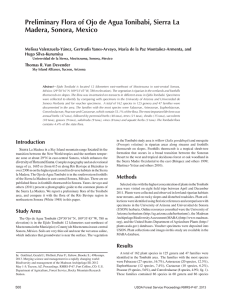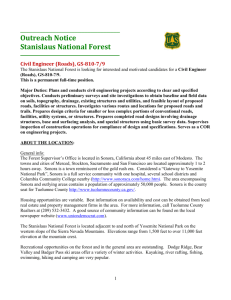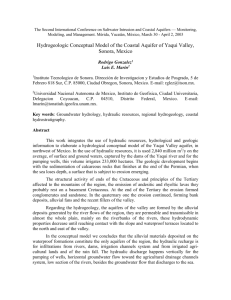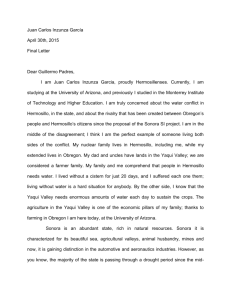Preliminary Flora of the Sierra Bacadéhuachi, Sonora, Mexico George M. Ferguson
advertisement
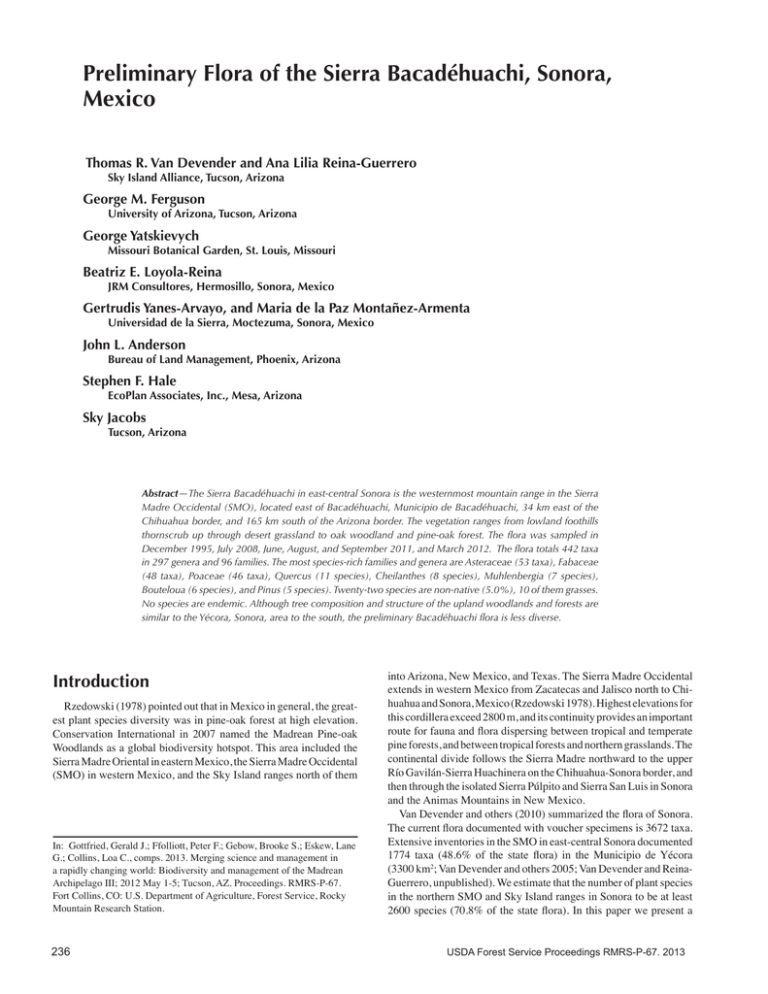
Preliminary Flora of the Sierra Bacadéhuachi, Sonora, Mexico Thomas R. Van Devender and Ana Lilia Reina-Guerrero Sky Island Alliance, Tucson, Arizona George M. Ferguson University of Arizona, Tucson, Arizona George Yatskievych Missouri Botanical Garden, St. Louis, Missouri Beatriz E. Loyola-Reina JRM Consultores, Hermosillo, Sonora, Mexico Gertrudis Yanes-Arvayo, and Maria de la Paz Montañez-Armenta Universidad de la Sierra, Moctezuma, Sonora, Mexico John L. Anderson Bureau of Land Management, Phoenix, Arizona Stephen F. Hale EcoPlan Associates, Inc., Mesa, Arizona Sky Jacobs Tucson, Arizona Abstract—The Sierra Bacadéhuachi in east-central Sonora is the westernmost mountain range in the Sierra Madre Occidental (SMO), located east of Bacadéhuachi, Municipio de Bacadéhuachi, 34 km east of the Chihuahua border, and 165 km south of the Arizona border. The vegetation ranges from lowland foothills thornscrub up through desert grassland to oak woodland and pine-oak forest. The flora was sampled in December 1995, July 2008, June, August, and September 2011, and March 2012. The flora totals 442 taxa in 297 genera and 96 families. The most species-rich families and genera are Asteraceae (53 taxa), Fabaceae (48 taxa), Poaceae (46 taxa), Quercus (11 species), Cheilanthes (8 species), Muhlenbergia (7 species), Bouteloua (6 species), and Pinus (5 species). Twenty-two species are non-native (5.0%), 10 of them grasses. No species are endemic. Although tree composition and structure of the upland woodlands and forests are similar to the Yécora, Sonora, area to the south, the preliminary Bacadéhuachi flora is less diverse. Introduction Rzedowski (1978) pointed out that in Mexico in general, the greatest plant species diversity was in pine-oak forest at high elevation. Conservation International in 2007 named the Madrean Pine-oak Woodlands as a global biodiversity hotspot. This area included the Sierra Madre Oriental in eastern Mexico, the Sierra Madre Occidental (SMO) in western Mexico, and the Sky Island ranges north of them In: Gottfried, Gerald J.; Ffolliott, Peter F.; Gebow, Brooke S.; Eskew, Lane G.; Collins, Loa C., comps. 2013. Merging science and management in a rapidly changing world: Biodiversity and management of the Madrean Archipelago III; 2012 May 1-5; Tucson, AZ. Proceedings. RMRS-P-67. Fort Collins, CO: U.S. Department of Agriculture, Forest Service, Rocky Mountain Research Station. 236 into Arizona, New Mexico, and Texas. The Sierra Madre Occidental extends in western Mexico from Zacatecas and Jalisco north to Chihuahua and Sonora, Mexico (Rzedowski 1978). Highest elevations for this cordillera exceed 2800 m, and its continuity provides an important route for fauna and flora dispersing between tropical and temperate pine forests, and between tropical forests and northern grasslands. The continental divide follows the Sierra Madre northward to the upper Río Gavilán-Sierra Huachinera on the Chihuahua-Sonora border, and then through the isolated Sierra Púlpito and Sierra San Luis in Sonora and the Animas Mountains in New Mexico. Van Devender and others (2010) summarized the flora of Sonora. The current flora documented with voucher specimens is 3672 taxa. Extensive inventories in the SMO in east-central Sonora documented 1774 taxa (48.6% of the state flora) in the Municipio de Yécora (3300 km2; Van Devender and others 2005; Van Devender and ReinaGuerrero, unpublished). We estimate that the number of plant species in the northern SMO and Sky Island ranges in Sonora to be at least 2600 species (70.8% of the state flora). In this paper we present a USDA Forest Service Proceedings RMRS-P-67. 2013 Preliminary Flora of the Sierra Bacadéhuachi, Sonora, Mexico preliminary flora of the Sierra Bacadéhuachi in the westernmost SMO to further document the biodiversity in this regional hotspot. Methods Study Area The Sierra Bacadéhuachi is the westernmost mountain range in the Sierra Madre Occidental, located east of Bacadéhuachi, Municipio de Bacadéhuachi, 34 km east of the Chihuahua border, and 165 km south of the Arizona border. Field activities were centered on Rincón de Guadalupe (29°50’40”N 108°58’37”W, 1680 m elevation) owned by the Catholic Archdiocese of Hermosillo. The southern portion of the Sierra Bacadéhuachi is in the Ríos Nácori Chico and Riíto drainages, with the Río Bacadéhuachi on the north, and looping around to west, all part of the greater Río Yaqui watershed. Elevations range from 700 m at Bacadéhuachi to 2400 m on the highest peak, an elevational range of about 1700 meters. Plants were observed and collected in Bacadéhuachi and the nearby arroyo, along the old and new roads between Bacadéhuachi and Nácori Chico, and the main Sierra Bacadéhuachi along the road to Rincón de Guadalupe and the high peaks above. Plant Collections Plants were collected under the SEMARNAT permit to J. Jesús Sánchez-Escalante, Curator of the Universidad de Sonora Herbarium (USON). Specimens were deposited into herbaria at the University of Arizona (ARIZ), USON, Arizona State University (ASU), and the Universidad Nacional Autónoma de México (MEXU). A few early plant records from the Bacadéhuachi area were found in the Southwest Environmental Information Network (SEINet) online database. In July 1940, Stephen S. White (1948), as part of his flora of the Río Bavispe region, made collections in La Palmita and the Aguage de Bacatejaca between Granados and Bacadéhuachi, and at La Galera (5 km N of Bacadéhuachi, 29°51’12”N 109°07’57”W, 715 m elevation). Between Bacadéhuachi and Nácori Chico, Joe T. Marshall collected Quercus tuberculata in June 1953 and Joe T. Marshall and Richard F. Felger collected Q. emoryi in June 1960. These were part of Marshall’s general tree inventories for his 1957 book “Birds of the Pine‑oak Woodland in southern Arizona and Adjacent Mexico.” Otherwise, the Sierra Bacadéhuachi plant collections and observations reported here were by the authors. Ferguson along with Mark Kaib, H. Mata-Mangueros, and A. Valencia-Cordoba visited the area in December 1995. Van Devender, Reina-Guerrero, and Loyola-Reina did plant transects in 11 thornscrub (FTS) areas along the route of the new road (completed in 2011) between Bacadéhuachi and Nácori Chico, all on the southern slopes of the Sierra de Bacadéhuachi. All authors participated in a Madrean Archipelago Biodiversity Assessment (MABA) Expedition trip to the Sierra Bacadéhuachi in August 2011. Van Devender and Reina-Guerrero, with the help of David G. Bygott, Marisa Rice, and Robert Villa, observed plants in the same area in June and September 2011 and March-April 2012. Nomenclature mostly follows the list in Van Devender and others (2010), which is available and updated in the Madrean Archipelago Biodiversity Assessment (MABA)/Southwest Environmental Information Network (SEINet) online database (Madrean.org). Plant collections, observations, and photographs from the study area are available in this database. A complete list of the Sierra Bacadéhuachi flora will be available as a Research Species list in the database. USDA Forest Service Proceedings RMRS-P-67. 2013 Van Devender and others Results Vegetation The vegetation on the southern lower flanks of the Sierra Bacadéhuachi is foothills thornscrub (FTS). This is the northern part of a very large expanse of FTS southward to where the Ríos Áros and Bavispe join to become the Río Yaqui, and merges into tropical deciduous forest (TDF) near San Nicolás. In the Sierra Bacadéhuachi, oak woodland is above desert grassland or FTS. Quercus chihuahuensis is the most common oak, with rare Q. emoryi and Q. tuberculata. With increasing elevation Q. arizonica, Q. oblongifolia. Quercus viminea, Pinus chihuahuana, and Arbutus arizonica become more common. At higher elevations, there is a mosaic of oak woodland on drier slopes and pine-oak forest in more mesic areas. With the addition of Q. hypoleucoides, Q. jonesii (= Q. coccolobifolia), Q. mcvaughii, and Q. tarahumara, the oak diversity in higher woodlands is comparable to the Yécora area in the SMO (166 km south), with Q. durifolia notably absent. Pine-oak forest is dominated by Pinus engelmannii, with P. arizonica and P. yecorensis locally common, and mixed oaks, Arbutus xalapensis, and Juniperus deppeana var. patoniana. At the highest elevations, P. strobiformis is present, and Q. rugosa is rare, with no presence of a mixed conifer zone (no Abies or Pseudotsuga). Riparian vegetation in drainages is linear, transecting other upland vegetation types. In the lowland tropical zone, riparian habitats are not well developed because FTS extends into the bottom of the drainages in most areas. Populus monticola and Salix bonplandiana were seen at Rancho el Carricito (916 m). The absence of Guazuma ulmifolia is of interest. This riparian tree is common and widespread in tropical southern Sonora, but apparently reaches its northern limit north of Tepache (53 km west-southwest) and on Rancho el Bábaco north of Sahuaripa (45 km south). White (1948) collected P. fremontii at La Galera (715 m) along Río Bacadéhuachi at FTS elevation. The arroyo at Rancho Agua Nueva (10 km east of Bacadéhuachi) in the desert grassland-FTS transition has P. fremontii and Platanus wrightii (1145 m). Salix gooddingii was only seen in Arroyo la Matancita (1600 m) in oak woodland near Rincón de Guadalupe. Riparian trees in Arroyo Campo los Padres at Rincón de Guadalupe are Alnus oblongifolia, Cupressus arizonica, and P. wrightii. We follow the classification used in Martin and others (1998) for vegetation names. Flora We identified 442 plant taxa in 298 genera and 96 families in the Sierra Bacadéhuachi area. The families with the most species are Asteraceae (53 taxa, 12.0%), Fabaceae (48 taxa, 10.9%), Poaceae (46 taxa, 10.4%), Euphorbiaceae (18 taxa, 4.1%), Pteridaceae (15 taxa, 3.4%), and Cactaceae (14 taxa, 3.2%). The genera with the most species are Quercus (11 taxa), Cheilanthes (8 taxa), Muhlenbergia (7 taxa), Bouteloua (6 taxa), Asclepias, Acacia, Euphorbia, Mimosa, and Opuntia, and Pinus (5 taxa each), and Ambrosia, Salvia, and Solanum (4 taxa each). The life forms in the Bacadéhuachi flora are herbs (49.5%, including grasses and sedges), woody plants (35.3%), and succulents (5.0%). Trees with 51 species (11.5%) are important in the flora and except for desert grassland, all of the vegetation types in the study area. The dicot herbs (219 taxa) are perennial (148 taxa) and annual (71 taxa). The grasses and sedges (46 taxa) are perennial (25 taxa) and annual (21 taxa). Only 22 species are non-native (5.0%), including ten grasses. Melinis repens is an Afro-Asian bunchgrass present in desert grassland, which has the potential to dominate and displace native perennial grasses. 237 Van Devender and others Brassica tournefortii, Cynodon dactylon, Pennisetum ciliare, and Sorghum halepense are invasive elsewhere in Sonora (Van Devender and others 2009), but not in the Bacadéhuachi area. Pennisetum ciliare is often planted in cleared desertscrub, thornscrub, and TDF in other areas in Sonora. Surprisingly, the only observation of it in the study area was 10.2 km east-southeast of Bacadéhuachi. Disturbance along the new highway will probably allow B. tournefortii, P. ciliare, and other non-native species to disperse into relatively intact FTS. Marrubium vulgare was locally common at Agua Nueva. Horehound or marrubio is a North African-Eurasian perennial herb that is almost always found in Sonora around stock corrals. It persists long after ranches are abandoned, but seldom spreads into natural habitats. A single B. tournefortii was collected in the town of Bacadéhuachi. Sahara mustard is a North African-European spring annual that is a serious invasive in low elevation Sonoran desertscrub in northwestern Sonora, southwestern Arizona, and southwestern California (Dimmitt and Van Devender 2009). Its arrival and expansion in other parts of Sonora is more recent. It was present in agricultural areas near Hermosillo in central Sonora in 1995 and west of Bacobampo in southern Sonora in 1993. Its dispersal mostly follows major highways. Between 2003 and 2005, it spread southward about 180 km along Mexican Federal Highway 15 (MEX 15) from Magdalena de Kino and Santa Ana south to Hermosillo. By 2008, it was in Guaymas, another 128 km to the south. In northern Sonora, it was found at 1109 m elevation in Sierra Cíbuta, 29 km south of Nogales on the Arizona border in 2005. By 2007, it was 25 to 41 km east of Agua Prieta along MEX 2 (156-172 km east of Nogales) at 1126-1295 m in cottonwood-willow riparian forest, Chihuahuan desertscrub, and desert grassland. By 2010, B. tournefortii was 48.5 km east of Agua Prieta at 1455 m elevation in desert grassland. Our 2012 collections of it in Baviácora in the Río Sonora valley, Granados in the Río Bavispe Valley, and Bacadéhuachi in the Río Yaqui drainage demonstrate that its dispersal into FTS in eastern Sonora is just beginning. These localities are 97 to 190 km to the northeast and east-northeast of the previous Hermosillo localities. Discussion In comparison with the intensely inventoried flora of the Municipio de Yécora, Sonora (36 trips in 1995-2008 by Van Devender and Reina-Guerrero) with 1774 plant taxa in 3300 km2, the flora of the Sierra Bacadéhuachi with 442 taxa is preliminary. The study area with an elevational range of 1700 m and a maximum elevation of 2400 m comparable to those of the Yécora area (1660 m range, 2140 maximum elevation) potentially has a much richer flora. Its affinities are strongly with the main SMO and lowland New World tropics of northwestern Mexico. Desmanthus illinoensis was collected on a disturbed roadside in FTS at 692 m elevation near Bacadéhuachi in 2008. This prostrate perennial herb with white flowers is widespread in the eastern United States as far west as New Mexico, but has not yet been collected in Arizona. The Lupinus aff. argenteus was collected in pine-oak forest at ca. 2300 m elevation near Cerro la Placa in December 1995. The nearest known populations are on the Continental Divide in the northern SMO of Chihuahua (70 km NNW) and in the Santa Catalina Mountains in Arizona (335 km north-northwest), but the high-elevation Madrean lupines in Sonora need taxonomic revision. Hexalectris revoluta was collected in oak woodland at 1680 m elevation at Rincón de Guadalupe in April 2012. This rare orchid, which was described from near Galeana, Nuevo León, is known from Texas, New Mexico, and Arizona. The nearest locality is in the Peloncillo Mountains of southwestern New Mexico (260 km north). Ribes dugesi is a Madrean pine-oak forest shrub previously only known in Sonora on Mesa el Campanero near Yécora (166 km south). Adolphia infesta 238 Preliminary Flora of the Sierra Bacadéhuachi, Sonora, Mexico collected in FTS at 1120 m at Rancho el Saucito (17 km southeast of Bacadéhuachi) in July 2008 is a rare spiny shrub in Sonora. Tithonia fruticosa is a large shrub/tree sunflower collected on Rancho el Embudo (10.3 km east of Bacadéhuachi) at 1215 m elevation in desert grassland in March 2012. Previously Carl V. Hartman collected it at Huehuerachi (Huepaverchi?) near Nácori Chico in December 1890 (NY) on the Lumholtz Expedition (Lumholtz, 1902) and Felger and Marshall collected it northeast of Nácori Chico in June 1960. This is the northernmost location for this tropical species. The vegetation of the Sierra Bacadéhuachi is similar to that along the MEX 16 highway in the Yécora area, except that desert grassland is present and TDF is not. The northernmost TDF is in the Sierra San Javier at ca. 28°45’N. The FTS in the Sierra Bacadéhuachi is the transition from the New World tropics to the northern temperate zone. To the north, FTS is replaced by desert grassland as winters become colder and periodic fires become ecological processes. The northern limits of FTS in Sonora are at about 30°11’N east of Sinoquipe in the Río Sonora Valley and 30°26’N at Presa Angostura on the Río Bavispe at the southern end of the Sierra El Tigre. Desert grassland is a vegetation type found from the Mexican Plateau in Coahuila, Chihuahua, and Durango north to southeastern New Mexico and western Texas and west to southeastern Arizona and northwestern Sonora. In Sonora, it occurs as far west as the Sásabe plains between the Sierra El Humo and the Baboquivari Mountains in Arizona. In northeastern Sonora, it forms a mosaic with Chihuahuan desertscrub as far south as Colonia Morelos and Carretas on the north and east sides of the Sierra el Tigre (White 1948). On the southwestern end of the Sierra Bacadéhuachi there is a large area of desert grassland dominated by Prosopis velutina at 1150 to ca. 1850 m elevation above FTS. This is one of the southernmost desert grassland areas in Sonora. The flora of the SMO is not well known. The Yécora area was included in the broad Río Mayo flora area in Martin and others (1998), but the only detailed publication is on the grasses (Van Devender and others 2005). The only published partial flora of a Sonoran Sky Island Mountain range is for the Sierra El Tigre as part of White’s (1948) flora of the Río Bavispe region. With the MABA/SEINet database, plant collections and observations from the SMO and various Sky Island ranges are becoming more available, but are not yet summarized in the literature. The Sierra Bacadéhuachi flora is an important contribution to the understanding of the biodiversity of the northern SMO and the Madrean Archipelago. Acknowledgments We thank Mike Bauer for his loving and meticulous identification of grasses. Enrique Yescas of SonoraEs magazine greatly facilitated fieldwork. Father Varela gave permission to stay at Rincón de Guadalupe. Reviews by Socorro González-Elizondo and Mark A. Dimmitt improved the paper. References Dimmitt, Mark A.; and Van Devender, Thomas R. 2009. Sahara mustard (Brassica tournefortii): A new, serious threat to low desert ecosystems in the southwestern United States and northwestern Mexico. Pg. 241-246 in Van Devender, Thomas R.; Espinosa-García, Francisco J.; Harper-Lore, Bonnie L.; and Hubbard, Tani. eds., Invasive Plants on the Move. Controlling them in North America. Proceedings of Weeds Across Borders 2006 Conference, Hermosillo, Sonora, May 25-28, 2006; Tucson, Arizona. Lumholtz, Carl S. 1902. Unknown Mexico: A Record of Five Years’ Exploration among the Tribes of the Western Sierra Madre; in the Tierra Caliente USDA Forest Service Proceedings RMRS-P-67. 2013 Preliminary Flora of the Sierra Bacadéhuachi, Sonora, Mexico of Tepic and Jalisco; and among the Tarascos of Michoacán. New York: Charles Scribner’s Sons. Marshall, Joe T., Jr. 1957. Birds of the pine‑oak woodland in southern Arizona and adjacent Mexico. Pacific Coast Avifauna, 32: 1‑125. Martin, Paul S.; Yetman, David A.; Fishbein, Mark; [and others], eds. 1998. Gentry’s Río Mayo Plants. The Tropical Deciduous Forest and Environs of Northwest Mexico. Tucson: University of Arizona Press. Rzedowski, Jerzy. 1978. Vegetación de México. México: Editorial Limusa, México. White, Stephen S. 1948. The vegetation and flora of the region of the Río de Bavispe in northeastern Sonora, Mexico. Lloydia, 11: 229‑302. Van Devender, Thomas. R.; Felger, Richard F.; Fishbein, Mark; Molina-Freaner, Francisco; Sánchez-Escalante, J. Jesús; and Reina-Guerrero, Ana L. 2010. Biodiversidad de las plantas vasculares. Pp. 229-262 in Molina-Freaner, Francisco; and Van Devender, Thomas R. eds., Diversidad Biológica de Sonora, Hermosillo: Universidad Nacional Autónoma de México. http://www. Van Devender and others skyislandalliance.org/Sonoran%20vascular%20plants-VanDevender%20 et%20al.2010.pdf Van Devender, Thomas R.; Felger, Richard S.; Reina-Guerrero, Ana L.; and Sánchez–Escalante, J. Jesús. 2009. Sonora: Non-native and invasive plants. Pp. 85-124 in Van Devender, Thomas R.; Espinosa-García, Francisco J.; Harper-Lore, Bonnie L.; and Hubbard, Tani. eds., Invasive Plants on the Move. Controlling them in North America. Proceedings of Weeds Across Borders 2006 Conference, Hermosillo, Sonora, May 25-28, 2006; Tucson, AZ. http://www.skyislandalliance.org/WAB06-c19-Van%20Devender%20 et%20al-Sonoran%20non-natives-Jan08.pdf Van Devender, Thomas R.; Reeder, John R.; Reeder, Charlotte G.; and ReinaGuerrero, Ana L. 2005. Distribution and diversity of grasses in the Yécora region of the Sierra Madre Occidental of eastern Sonora, Mexico. Pp. 107-121 in Cartron, Jean-Luc E.; Ceballos, Gerardo; and Felger, Richard S. eds. Biodiversity, Ecosystems, and Conservation in northern Mexico. New York: Oxford University Press. The content of this paper reflects the views of the authors, who are responsible for the facts and accuracy of the information presented herein. USDA Forest Service Proceedings RMRS-P-67. 2013 239
